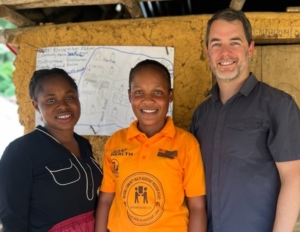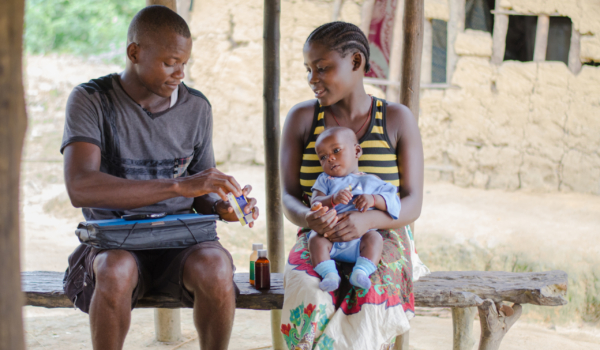By James Nardella, Chief Program Officer
On July 1, Last Mile Health launched a new five-year strategic plan, Closing the Distance. At this moment of transition, there is cause for hope. Alongside ministries of health, funding and technical partners, and the community health workers whose daily work puts our mission into practice, here is the progress we’ve helped enact in the past four years—and why we must stay the course to catalyze lasting change:

Community health supervisor Eunice Feekpeh, community health worker Hannah Lincoln, and Chief Program Officer James Nardella.
- We launched new government partnerships in Ethiopia, Malawi, and Sierra Leone.
- We marked 15 years of partnership in Liberia, where we worked with the Ministry of Health to scale the National Community Health Program. Today, community health workers treat 45% of all reported malaria cases in children under five.
- Across these countries, nearly 10,000 community and frontline health workers provide nearly 8 million people with essential primary healthcare.
And this quarter, we marked significant milestones:
- In Ethiopia, the Ministry of Health formally adopted the blended learning approach for the training of all 40,000 community health workers following the success of a pilot program.
- After playing a key role in the Monrovia Call to Action, the Liberian government published a new national community health policy.
- In Malawi, alongside exciting progress on the integrated National Community Health Information System, the government launched a new national community health framework.
- With Sierra Leone’s Ministry of Health, we disseminated Exemplars in Global Health research findings, a key progress point in strengthening the national community health worker program.
We should be proud of these milestones: they represent real progress toward the development and strengthening of four exemplary community health systems, which means better training and support for community health workers—and improved access to care for patients in the poorest, the most vulnerable, and the most remote communities. And we must recognize that these accomplishments are not the product of the past quarter: they are the product of years of patient accompaniment. We must remain committed to our vision: a health worker within reach of everyone, everywhere. Long-term investment is what we need to get this work done.
At Last Mile Health, we are committed to walking alongside our government partners to the last mile. To support transformative systems change in the countries where we work, we must be partners who stay. We measure progress across decades, not quarters, as we work to design policies that work—and then to turn paper to practice.
We are on the right path. We used to enter rooms trying to make the argument on why community health workers matter. Now, we’re being asked, “How do you do that? What does a community health worker program look like when it’s high quality, when it’s at national scale—and can you help?” We see momentum in the energy around Africa Frontline First as well as in the milestones we marked this quarter. We see it globally in the lead-up to the UN General Assembly and High-Level Meetings around the call to accelerate our path towards universal health coverage. We can’t achieve this without investing in community health workers.
At the heart of it, too often where you were born determines whether you receive healthcare. The only way to close the distance is by investing in community health workers and the systems that support them. This is how we can ensure a child in Liberia receives a quick diagnosis and effective treatment for malaria. It’s how we can ensure a community health worker in Ethiopia has dynamic training to recognize complications in a mother’s pregnancy and refer her to a facility. It’s how we can ensure health leaders identify and respond to outbreaks thanks to real-time reporting at the community level. It’s how we can ensure governments can look to exemplary community health systems we have partnered to develop and sustain—and build their own programs. It’s how we can ensure everyone, everywhere can access quality primary care.
This is the future we know is possible. Together, with patience and purpose, we can achieve it.
This post was originally published as part of Last Mile Health’s April-June 2023 quarterly report. Read the full report here.






